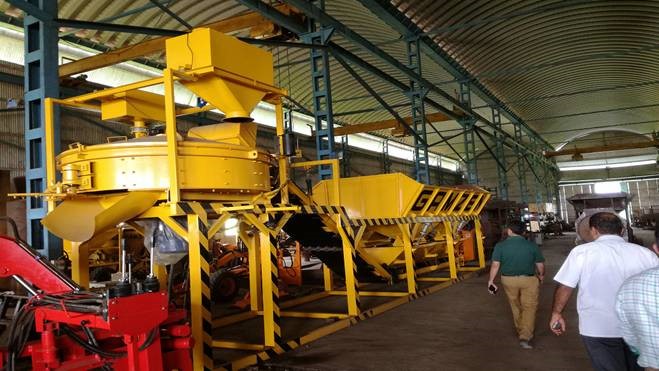Concrete Batching Plants: A Step Towards Sustainable Construction
Concrete batching plants have become an integral part of sustainable construction, owing to their several advantages. These plants are defined as machines that combine various ingredients like sand, aggregates, water, and cement to form concrete. The need for sustainable construction arises from the fact that traditional construction methods are energy and resource-intensive, leading to increased carbon footprint and environmental degradation. Concrete batching plants contribute substantially to the cause of sustainability by reducing wastage, recycling water, reusing materials, and reducing the carbon footprint. With such benefits, it is no wonder that construction companies are increasingly adopting concrete batching plants as a step towards sustainable construction.
What are Concrete Batching Plants
Concrete Batching Plants are facilities that mix various aggregates with water, cement, and any other admixtures to produce concrete. These plants range from small-sized ones to large industrial plants, depending upon their capacity and utility. The mobile batching plant, on-site batching plant, and central mix plant are the three primary types of Concrete Batching Plants. The components include mixers, conveyors, aggregate bins, cement bins, and heaters.
Concrete Batching Plants offer a range of benefits- they are efficient, eco-friendly, and improve quality control. Using these plants reduces wastage, carbon footprint, and even allows the reuse of materials. Technological advancements and increasing demand for sustainable construction have propelled the future of these plants. However, the costs involved, maintenance and upkeep of these facilities, and their environmental impact present challenges to their sustainability.
Advantages of using Concrete Batching Plants
Concrete Batching Plants offer a number of advantages over traditional methods of concrete production. Firstly, they provide greater efficiency by automating the process and reducing the need for manual labour. This leads to faster production times and fewer errors in the concrete mix. In addition, Concrete Batching Plants offer improved quality control by allowing for precise measurement of the various ingredients that go into the mix. This results in a consistent quality of concrete that meets the specific requirements of the project.
Another major advantage of Concrete Batching Plants is that they reduce the environmental impact of concrete production. By providing more accurate measurements, the amount of waste produced is reduced. In addition, many plants now incorporate recycling systems that allow for the reuse of water and other materials. This helps to reduce the overall carbon footprint of the concrete production process.
Overall, Concrete Batching Plants are a significant step towards sustainable construction. They offer several advantages, including greater efficiency, reduced environmental impact and improved quality control. While there are challenges and limitations associated with their use, the benefits far outweigh the costs. As demand for sustainable construction continues to grow, it is likely that we will see even more technological advancements in the Concrete Batching Plant industry.
How Concrete Batching Plants Support Sustainable Construction
When it comes to sustainable construction, there’s no denying the importance of reducing wastage, recycling water, reducing carbon footprint, and reusing materials. Concrete batching plants play an essential role in making all this happen. By using advanced processes and technologies, they help to ensure that the materials used in construction are of the highest quality and that there is minimal wastage during production.
Moreover, concrete batching plants make use of recycled water, which is an important resource given the increasing concerns over water scarcity. By reusing materials and reducing waste, these plants also help to reduce the carbon footprint generated during construction.
However, it’s worth noting that there are some challenges with using concrete batching plants, including the costs of investment and the environmental impacts of the production process. Nonetheless, with the increasing demand for sustainable construction practices, it’s clear that the future of concrete batching plants is bright. With further research and development, these plants will undoubtedly become even more efficient and cost-effective, making them an even more attractive option for sustainable construction projects.
The Future of Concrete Batching Plants in Sustainable Construction
As construction moves towards sustainability, the role of concrete batching plants becomes ever more vital. The future of these plants lies in technology, research, and development. Advancements in automation, smart sensors, and artificial intelligence are expected to make concrete production and mixing more efficient and streamlined, reducing costs without sacrificing quality. Increasing demand for sustainable construction will continue to fuel innovation in the field of concrete batching. Progressive steps like water recycling, carbon capture, and responsible sourcing of raw materials will further reduce the ecological impact of concrete batching plants. Collaborative efforts between manufacturers, designers, and contractors will continue to yield breakthroughs that make sustainable construction a reality. While the costs and environmental impact of concrete batching can be significant, the benefits of adopting these practices could not be more important.
Challenges and Limitations
Concrete Batching Plants come with a few challenges and limitations that hinder their adoption in sustainable construction. Firstly, they require a significant amount of initial investment and operational costs. This could be a challenge for small-scale construction projects. Additionally, these plants require regular maintenance and upkeep to ensure optimal performance and longevity. Although routine maintenance is crucial, it can add to the costs of the project.
Another limitation is the environmental impact. The production process can emit large amounts of carbon dioxide and other greenhouse gases. The noise and dust created during the production process can also have a negative impact on the nearby community. Despite these challenges, some environmental regulations and compliance have significantly reduced these impacts.
To overcome these challenges, it’s essential to develop new methodologies that reduce the environmental impact and lower the cost of investment while ensuring high-quality standards. The increased adoption of new technologies and innovations in the construction industry could also significantly improve the efficiency and sustainability of concrete batching plants. As technology advances and environmental regulations continue to tighten, the challenges facing concrete batching plants can be overcome.
Conclusion
In summary, Concrete Batching Plants offer many advantages in terms of efficiency, reduced environmental impact, and improved quality control. They also contribute to sustainable construction by reducing wastage, recycling water, and reusing materials. Advancements in technology and increasing demand for sustainable construction present a promising future for their use. However, the cost and environmental impacts must also be taken into account. It is important to prioritize sustainable construction for the betterment of our planet.

